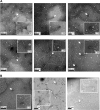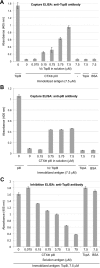The Vibrio cholerae minor pilin TcpB mediates uptake of the cholera toxin phage CTXφ
- PMID: 31471320
- PMCID: PMC6816102
- DOI: 10.1074/jbc.RA119.009980
The Vibrio cholerae minor pilin TcpB mediates uptake of the cholera toxin phage CTXφ
Abstract
Virulent strains of the bacterial pathogen Vibrio cholerae cause the diarrheal disease cholera by releasing cholera toxin into the small intestine. V. cholerae acquired its cholera toxin genes by lysogenic infection with the filamentous bacteriophage CTXφ. CTXφ uses its minor coat protein pIII, located in multiple copies at the phage tip, to bind to the V. cholerae toxin-coregulated pilus (TCP). However, the molecular details of this interaction and the mechanism of phage internalization are not well-understood. The TCP filament is a polymer of major pilins, TcpA, and one or more minor pilin, TcpB. TCP are retractile, with both retraction and assembly initiated by TcpB. Consistent with these roles in pilus dynamics, we hypothesized that TcpB controls both binding and internalization of CTXφ. To test this hypothesis, we determined the crystal structure of the C-terminal half of TcpB and characterized its interactions with CTXφ pIII. We show that TcpB is a homotrimer in its crystallographic form as well as in solution and is present in multiple copies at the pilus tip, which likely facilitates polyvalent binding to pIII proteins at the phage tip. We further show that recombinant forms of TcpB and pIII interact in vitro, and both TcpB and anti-TcpB antibodies block CTXφ infection of V. cholerae Finally, we show that CTXφ uptake requires TcpB-mediated retraction. Our data support a model whereby CTXφ and TCP bind in a tip-to-tip orientation, allowing the phage to be drawn into the V. cholerae periplasm as an extension of the pilus filament.
Keywords: CTXφ; TcpB; Vibrio cholerae; X-ray crystallography; bacteriophage; minor pilins; pIII; protein structure; toxin coregulated pilus; type IV pili.
© 2019 Gutierrez-Rodarte et al.
Conflict of interest statement
The authors declare that they have no conflicts of interest with the contents of this article
Figures







Similar articles
-
Crystal structures of a CTXphi pIII domain unbound and in complex with a Vibrio cholerae TolA domain reveal novel interaction interfaces.J Biol Chem. 2012 Oct 19;287(43):36258-72. doi: 10.1074/jbc.M112.403386. Epub 2012 Aug 31. J Biol Chem. 2012. PMID: 22942280 Free PMC article.
-
The Vibrio cholerae Minor Pilin TcpB Initiates Assembly and Retraction of the Toxin-Coregulated Pilus.PLoS Pathog. 2016 Dec 19;12(12):e1006109. doi: 10.1371/journal.ppat.1006109. eCollection 2016 Dec. PLoS Pathog. 2016. PMID: 27992883 Free PMC article.
-
Effects of tcpB Mutations on Biogenesis and Function of the Toxin-Coregulated Pilus, the Type IVb Pilus of Vibrio cholerae.J Bacteriol. 2016 Sep 22;198(20):2818-28. doi: 10.1128/JB.00309-16. Print 2016 Oct 15. J Bacteriol. 2016. PMID: 27481929 Free PMC article.
-
Phage-bacterial interactions in the evolution of toxigenic Vibrio cholerae.Virulence. 2012 Nov 15;3(7):556-65. doi: 10.4161/viru.22351. Epub 2012 Oct 17. Virulence. 2012. PMID: 23076327 Free PMC article. Review.
-
Filamentous phages linked to virulence of Vibrio cholerae.Curr Opin Microbiol. 2003 Feb;6(1):35-42. doi: 10.1016/s1369-5274(02)00005-x. Curr Opin Microbiol. 2003. PMID: 12615217 Review.
Cited by
-
Fresh Extension of Vibrio cholerae Competence Type IV Pili Predisposes Them for Motor-Independent Retraction.Appl Environ Microbiol. 2021 Jun 25;87(14):e0047821. doi: 10.1128/AEM.00478-21. Epub 2021 Jun 25. Appl Environ Microbiol. 2021. PMID: 33990308 Free PMC article.
-
Vibrio Pathogenicity Island-1: The Master Determinant of Cholera Pathogenesis.Front Cell Infect Microbiol. 2020 Oct 6;10:561296. doi: 10.3389/fcimb.2020.561296. eCollection 2020. Front Cell Infect Microbiol. 2020. PMID: 33123494 Free PMC article. Review.
-
Structure and function of minor pilins of type IV pili.Med Microbiol Immunol. 2020 Jun;209(3):301-308. doi: 10.1007/s00430-019-00642-5. Epub 2019 Nov 29. Med Microbiol Immunol. 2020. PMID: 31784891 Free PMC article. Review.
-
Fitness Trade-Offs Resulting from Bacteriophage Resistance Potentiate Synergistic Antibacterial Strategies.Infect Immun. 2020 Jun 22;88(7):e00926-19. doi: 10.1128/IAI.00926-19. Print 2020 Jun 22. Infect Immun. 2020. PMID: 32094257 Free PMC article. Review.
-
Mechanism of secretion of TcpF by the Vibrio cholerae toxin-coregulated pilus.Proc Natl Acad Sci U S A. 2023 Apr 18;120(16):e2212664120. doi: 10.1073/pnas.2212664120. Epub 2023 Apr 11. Proc Natl Acad Sci U S A. 2023. PMID: 37040409 Free PMC article.
References
Publication types
MeSH terms
Substances
Associated data
- Actions
- Actions
LinkOut - more resources
Full Text Sources
Molecular Biology Databases

